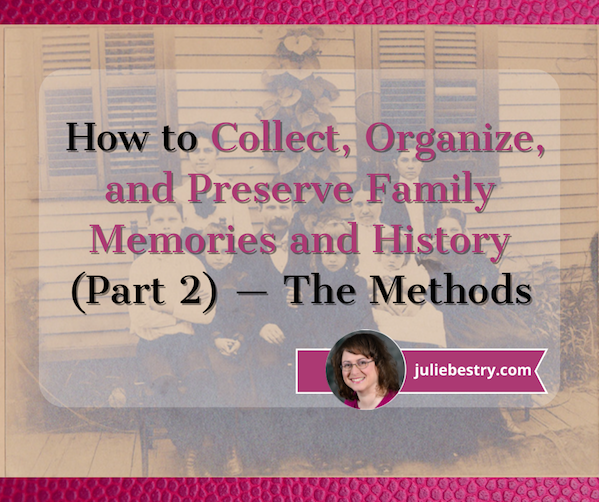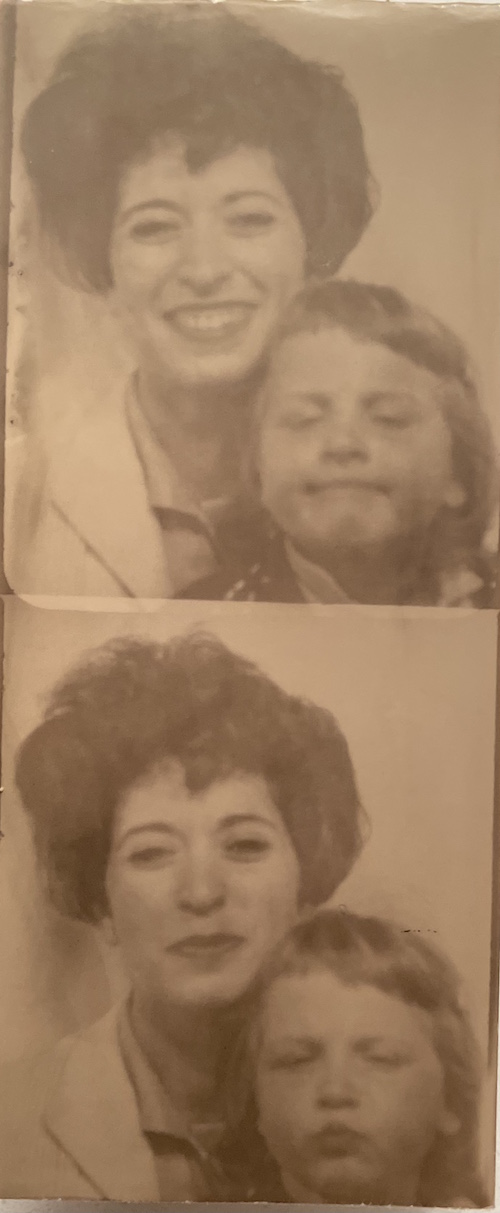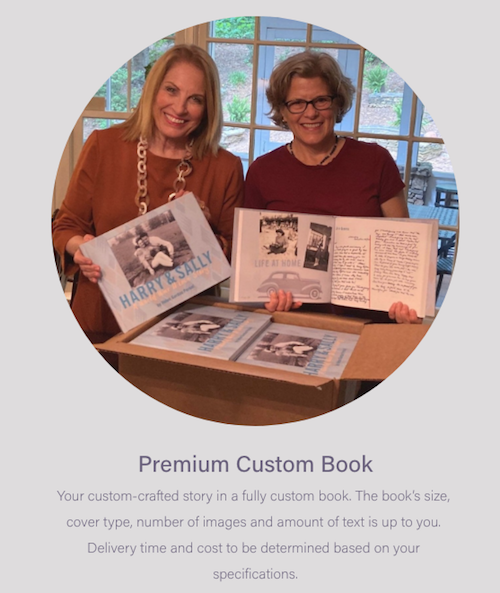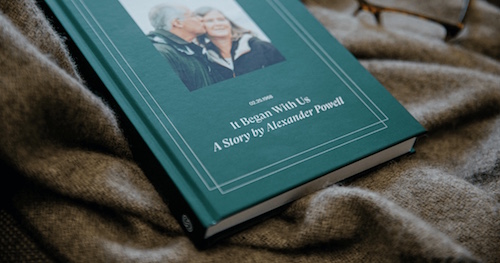How to Collect, Organize, and Preserve Family Memories and History (Part 2) — The Methods

Last week, in How to Collect, Organize, and Preserve Family Memories and History (Part 1) — The Questions we looked at why you might want to collect family memories and stories.
It’s easy to think that it’s all about “genealogy,” which can seem like a dry topic to those who haven’t delved into wacky and wondrous family stories. But we saw how embracing family history can do more than clarify what’s happening in family photos (or make those strangers in black-and-white come alive and feel more three-dimensional). Family stories can help tether us to a genetic continuum and weave us into a tapestry going back generations and extending broadly across time and locations.
For example, when I started my business, I felt like I was adrift, the first person to really “start” a business. When asked for her profession, Paper Mommy usually puts down “part-time brain surgeon” for fun, and while motherhood is an intellectual and physical triumph, it doesn’t ecacly bring in the Benjamins. My father was an attorney and judge, but in the late 1940s, he joined an already existing practice.
But focusing on those stories I told you last week, I can place myself along a continuum of business owners: my material great-grandfather owned his own bakery (with my great-grandmother, who ran it); my paternal grandfather, who co-owned a tailors’ notions shop; my maternal grandfather, who traded in scrap metal (though decommissioned battleships seem more grandiose than “scrap” would imply).
Last week’s post also detailed a wide variety of questions to help get conversations started about family history and memories. We know that some people (and some generations) find it hard to talk about themselves, so it’s no surprise their children don’t ask questions; they don’t realize there’s anything to ask! Hopefully, the prompts I provided last week will give you a starting point to talk with your family about the rich tapestry of their lives.
But what will you do with these stories once you’ve gathered them, and how will you preserve them for future generations?
HOW TO CAPTURE MEMORIES AND STORIES — THE BASICS
Capturing your loved ones’ stories can be as simple or as robust as you choose, and you don’t necessarily have to invest in apps or platforms in order to create a record of someone’s legacy.
Take notes
Start with the basics. If you just want to make sure you get the details of what happened, you could take notes as your Grandpa tells his stories.
Scribbling notes by hand can be more surreptitious; even though we know that taking notes on our phones or computers is more efficient, and putting them into Evernote or even a Google doc will come easily, typing while they’re talking may seem dismissive to older folks. (Don’t we all feel like our doctors aren’t paying attention to us when they stay buried in their computers, tapping away as we describe our ills?)
There are only slightly more complex technological options that, once they are set up, allow you to interact more freely and naturally.
Capture your conversation with audio
The voice memo function on your phone or computer is a good choice when you’re in the middle of cooking or traveling and your relative surprises you by telling a story. You can quickly record them without missing a detail.

On iPhone, use the robust Voice Memo app. (It’s in your utilities folder, but for easier access, put it on your home screen.) On Android, use the built-in Sound Recorder app or download any of a variety of free or paid audio apps.
Shoot video of family stories
Using video adds even more color to a family story than just audio, but capturing it can be touchy. The last thing you want is for your Auntie to feel like the paparazzi are sticking cameras in her face, and you don’t want her to be focused on how she looks.
GenZ, Gen A, and younger millennials use their phones as if they are extensions of their fingers. Depending on your age and experience, you may be all-thumbs or quite adept at shooting video with your phone. The more easily you grab your phone and unobtrusively focus and hold it still, the more at ease Great-Grandma will be at telling her story of how she came to America.
If you can turn on your phone, set it up to stay steady, and give all of your attention to the narrative, everything will go more smoothly. Otherwise, develop a shorthand with your teen or tween, so while they play cinematographer, it lets you take the role of interviewer.
Set up a remote video call
The above options work great if you’re taking advantage of serendipity and spontaneously capturing a relative telling a story. But if you want to plan to capture memories, you’ll need to add some structure.
One good option is setting up Zoom, or any similar remote video service, and starting a conversation that way. There are a view key issues to consider:
- Ease of use — The basics of Zoom aren’t difficult; Paper Mommy is 88, and like most people, she took to using Zoom during the pandemic. But the email invitations, with the myriad links and phone numbers, can be overwhelming to users of all ages. When you set up a call, make sure that your interviewee(s) have as little confusion as possible; pare down the instructions to the absolute essentials or do it when someone in the family or a friend can help them set up. Nobody is at their storytelling best after thirty minutes of fighting their technology.
- Preparation vs. capturing lightning in a bottle — You know your family members. Some might freeze up if they’re asked questions; if their Nervous Nellies, send them at least a few of the prompting questions a day or two in advance. Other folks work best when they are spontaneous. You’ll need different methods for different family members.
- Recording — Pick a robust video platform option that allows you to record the call and access the file quickly and easily.
- Screen-sharing and other features — If you want to use photos to help prompt someone’s recall, make sure your video platform has a screen-sharing function, and set up the photos in a folder or slide-show, so you aren’t so distracted by the fiddly stuff that you break up the flow of your storyteller’s narrative.
You can work your way through the prompt questions I provided last week, but be sure you leave space for them to go off on tangents and surprise and delight you with unexpected tales!
Incorporate family photos into their stories
If you are handy with DIY, there are online companies where you can combine photos and text (like family stories) into a photo book (or a series of them). Popular sites include:
- Shutterfly — Browse from a collection of templates, select one, and upload your photos in JPEG format) into the pre-selected slots. Then add text, design elements, and other customizations. Shutterfly also has a free 24-hour designer service.
- Mixbook — Customize the design complexity and apply styles and themes.
- Google Photos — With prices starting at $14.99, you can customize hardcover or softcover book with custom captions, text, and collages on any page.
The above options help preserve visuals, but offer limited space for narratives.

These snaps of Paper Mommy and my sister illustrates just one of a several family stories regarding my mother doing our hair. Here, Paper Mommy zealously, lopsidedly cutg my sister’s bangs. Luckily, there are no photos of the day I was sent out into the world with pink hair-setting tape still in my hair.
However, if you’d prefer a more white glove service rather than fighting with online settings, consider something like Jiffy Page‘s Pixorium. I’ve worked with clients to help them pare down their photos and then hand them off to Pixorium to scan and preserve digitally. They do a stellar job, but where they really shine is in helping develop custom story books.

Pixorium doesn’t just help preserve photos and make story books. Jiffy’s people are storytellers. Bring your photos, tell your story, even provide a manuscript of family history. Pixorium will listen, ask questions, and create a book that respects and reflects your family’s legacy. (Be sure to check out Pixorium’s YouTube page for great photo and legacy advice.)
Explore creative options for collecting family memories
The above options are more familiar, straightforward approaches to getting your family to tell stories and capture them, but if your family is up for some adventure, try something atypical.
This summer, I was intrigued by Perfect Pixel Moment‘s blog post on Medium, 12 New Ways to Preserve Family Memories, which included ideas like creating a family podcast series, developing a family blog, producing multi-generational family cooking videos, and more. Check it out.
What to do with what you collect
What you do with the notes, audios, and videos you capture is up to you. As with tangible organizing, you have to sort, merge, and edit your specific categories before organizing things into final form.
Whether you share raw footage or edit everything into a meaningful presentation, a documentary, or private YouTube channel is your choice. For now, focus on gathering and preserving the information while your storytellers are with you and up to the task of narrating their rich histories.
PLATFORMS FOR CAPTURING FAMILY MEMORIES IN BOOK FORM
There a huge number of services and apps designed to help you collect, organize, preserve, and share your family’s memories. The rest of this post explores just a few.
Storyworth
Storyworth is a subscription-based service. You select a weekly email prompt from the database of hundreds of “tell me about your life” questions. Your recipients respond with their own emails.
Unlike the broad, overarching prompts I suggested in last week’s post, Storyworth’s questions are more pointed and varied, including, “Can you sing your favorite lullaby?” and “What is one of your greatest fears?” (You can also edit the suggested questions or use your own.)
Stories are private by default and available to download by only authorized family members. At the end of the year, the responses to the prompts are bound into a book.

A standard package includes a year’s worth of weekly story prompts to help you interview one “storyteller,” online access for an unlimited number of family members (as authorized by you), and one 6″ x 9″ hardcover book with a black & white interior and a full color cover.
You can’t apply any of your own formatting, change fonts, etc., but the books can include photos. (The storyteller attaches photos to their email responses.) Once the responses are submitted, you and/or the storyteller can log in and edit responses and add captions to the photos, though some online reviews have mentioned the editing process can be finicky.
Extra books can be ordered, as follows:
- $39: Black and white interior, up to 480 pages
- $79: Color books, up to 300 pages
- $99: Color books above 300 pages, up to 480 pages
If you purchase multiple subscription packages, you can opt to blend multiple family members’ stories into one book.
A package is $99 for a year, with domestic shipping included.
Founded by Nick Baum to capture his father’s stories, Storyworth is independent and family-owned, and has been in business for over a decade.
Storyworth is best suited for a loved one who is comfortable with technology, in good enough health to read on-screen prompts and reply on their own, and eager enough to overcome procrastination or inertia and respond to a weekly email.
You know your relatives best. Will they feel like this is homework to slog through or an opportunity to shine?
Because stories are captured in print form (even with photos), they lack the vividness of platforms with audio and/or video. However, history tells us that print books will always be accessible, while digital A/V formats quickly become obsolete.
My Life In a Book
A similar biographical approach is offered by My Life in a Book, with questions selected from a database (though you can create your own questions to reflect the uniqueness of your relatives’ experiences).
Prompts come to your recipient via email, and replies are returned similarly, though there is a voice-to-text option, which allows someone to narrate stories directly into the online system.
Additionally, unlike the weekly flow of Storyworth, My Life in a Book allows you to customize the frequency of the arrival of the questions. Chatty Cathy can get them faster; Silent Sam can be asked less often.
This platform has a more structured biographical approach, with themes for the books:
- Preserving Memories fits the theme of tracking the lives of parents and grandparents
- Baby’s First Moments preserves important memories for new parents
- The Story of Us helps couples track their lives together
- I’m Writing a Book About You lets you create a book for and about a special loved one
My Life in a Book offers collaborative editing, so both the storyteller and any family members with access can help edit responses and even add photographs. You can also get real-time notifications to update you when your loved one has responded.
Users have input into the final book, including selecting from a variety of cover designs, choosing from a palette of color themes, and choosing different cover font text (but not interior fonts). Depending on the selected style, you may either select a pre-designed image or use a custom photo.
My Life in a Book is also $99, and shipping of books is free domestically and to Canada, UK, Australia, and New Zealand; there are shipping fees to other countries. Upgrades (at additional cost) include audiobook versions, additional print copies, and gift boxes for print books.
Remento
Remento is a worth considering if your loved one might feel more comfortable narrating a story rather than typing it.
There are still weekly prompts (which can include user-provided photo prompts), but the storyteller speaks the response into the system using a smartphone or computer; there are no logins or downloads, and reviewers report that it only requires a few clicks to get started.
Remento records and transcribes the recordings into stories printed as hardcover books.
Additionally, the books are printed with QR codes, which, when scanned, play the original recording used to write the chapters. Thus, future generations not only get the book, but get to hear the voice of the storyteller (at least as long as Remento is in business).
Remento uses artificial intelligence. Once the narration is recorded, you get to choose your preferred writing style (first-person, third-person, or transcript). From there, Remento’s Speech-to-Story™ AI technology turns your storyteller’s voice into a polished, edited written narrative. You can also customize the book’s title, color, and cover photo.
Remento is currently priced at $99, for which you get unlimited prompts and recordings, unlimited collaborators, and one premium, color-printed book. (If you subscribe to their mailing list at the bottom of the front page and are willing to get updates and notifications for sales and giveaways, you get $10 off.)
Remento is a little more focused on the journey (involving the whole family in encouraging responses to the prompts) than the destination (creating a book). All authorized family members can collaborate, watch the recordings as they’re submitted, send reactions to what’s been created (thereby providing the family storyteller with positive feedback), and select new prompts for future use.
As with the above options, your loved one will still need to keep up with prompts to get value, but the easy audio interface may make the experience more inviting than having to reply in writing.
Getting reactions on each uploaded story may be a positive experience (like getting a thumbs-up “like” on Facebook) or might be distracting and yield self-consciousness.
MULTIMEDIA PLATFORMS FOR PRESERVING FAMILY HISTORY
Books are fabulous, and your great-great-great-great grandchildren will probably be able to read text, as long as it’s not written in cursive. But if you want your family’s memories to come alive, and you want your own grandchildren to feel like they really knew your grandparents, there’s no substitute for audio and video.
StoryCorps
StoryCorps is a grand-daddy (or grand-mommy) of preserving family legacies, dating back to 2003, but it comes at it from a different perspective from most other platforms.
StoryCorps is a nonprofit project founded by a public radio producer, committed to the notion that we all have important stories to tell and that ALL of our stories matter. StoryCorps mission is to “help us believe in each other by illuminating the humanity and possibility in us all — one story at a time.”
I have a lump in my throat just reading that!
StoryCorps has a collection of more than 700,000 stories, the largest archive of its kind. Rather than creating a recorded family history for just generations of your people, you can create a story for future generations of people all over.
You have a few options for creating stories:
- Record with StoryCorps’ self-directed tools. If you can get in the same room with your loved one, use the StoryCorps App. Use my prompts from last week’s post, invent your own, or use StoryCorps’ prompts — then ask away. Alternatively, if your loved ones are elsewhere, whether across the city or across the world, you can record stories together via your web browsers using StoryCorps Connect. Either way, you can preserve your conversations using StoryCorps DIY resources.
- Alternatively, you and a loved one can record a conversation at one of the StoryCorps recording sites with the help of a facilitator. This adds a nice professional layer to the question-and-answer experience and may help your loved one feel more inspired. At the end of the session you get a recording of your interview and a copy is sent to the American Folklife Center at the Library of Congress. Talk about legacy!
- StoryCorps Mobile Tours — Each year for the last 15 years, StoryCorps has been going on a nationwide mobile tour. As I was writing last week’s post, I just happened to learn that they’re just up the road from me in Knoxville, TN, through the end of the month!
- StoryCorps Atlanta Booth — The StoryCorps facility at the Atlanta History Center has recorded and preserved thousands of conversations since 2013. If you’re in or near Atlanta, book an appointment to “interview” your loved one in person or even virtually, by phone. (They can feel like they’re on NPR, being interviewed by Terry Gross or Mary Louise Kelly!)
- Military Voices Initiative — This program provides a way for service members, veterans, and military families across America to honor and listen to their loved one’s stories. Book an appointment to preserve their memories (and your questions) in person or virtually at one of their Military Voices Initiative stops.
Some segments may even air on NPR, and I’ve seen beautiful StoryCorps personal histories set to animated video on StoryCorps’ TikTok channel. In fact, the following video prompted this part of the post series.
For more stories, see StoryCorps’s archive and YouTube page.
StoryCorps is free to all users.
Obviously, StoryCorps isn’t the right option for capturing an entire lifetime of memories, let alone the stories of all of your loved ones. However, the professionalism of the production experience may inspire your family members who may be dubious about having something to say, or who are shy about sharing their stories, to open up a bit. Consider StoryCorps as a way to delight in the storytelling experience and use it as an on-ramp for refreshing memories.
STORII
Storii recognizes that not everyone is going to be comfortable with typing their stories or even clicking around on an app or website. It’s designed for Great-Grandpa, who grunts at computers and cell phones whenever he sees them in public. (And for folks who, for whatever reason, have difficulty with technology.)
Storii uses actual phone calls to collect memories. Unless Great-Grandpa predates Alexander Graham Bell inventing the telephone in 1876, I think you’re safe.

Set up an account profile (in Storii’s iOS or Android app) for your loved ones to receive phone calls, whether on a cell phone or landline; alternatively, they can call in. (No smartphone or internet is required.)
Next, choose prompting questions from more than 1000 life story questions in their database (broken down into guiding categories like life, family, religion, career, or legacy), and/or craft some of your own.
Schedule up to three automated incoming calls per week at a time you know is good for your loved one, or arrange for them to call in to record their responses. Storii records and transcribes the calls, and adds them to your profile.
Record interactive responses. You and other family members can listen to the recordings and respond with audio, video, photo, and text responses.
Access the recordings as audiobooks or downloadable PDF books. Recordings can be shared with other family members by secure links or via emails.
If you think your storytellers won’t be at ease if they’re “surprised” by a question (even on a scheduled call), there are a few options.
They (or you) can log in to their Storii profile to see all upcoming questions (and remove, re-order, or add custom questions). If your loved ones don’t have (or don’t want to use) internet, and aren’t keen on getting you involved, they can call in to Storii at any time to hear their next upcoming question.
They can also just hang up after they hear the question on the scheduled call, and Storii will keep asking the same question until it’s either answered or skipped.
Storii’s pricing is $9.99/month or $99/year.
We have just scratched the surface of the DIY options and formal platforms for capturing, organizing, and preserving your family’s stories. But Paper Doll has one more trick up her sleeve. Next week, we’ll close out this series with AI-assisted platforms and apps for creating those family legacies. See you next time!




I would like someone to sign me up for one of those services that sends you a prompt and your answers go into a book. Can you tell my kids?
LOL, I think you’re joking, but I’d be happy to send a postcard signed “from a little birdie” if you message me a name and address. 😉
Would you prefer to answer the questions by email or phone? I’m serious, I’ll let them know! I think it’s a stellar idea for a holiday gift!
I’ve heard of many of these, but not StoryCorps. That is a very interesting approach. I think having a neutral party facilitating might be handy. Of course, it might also feel too formal. You gotta know your peeps, right?
I believe my husband and his siblings got the StoryWorth for my mother-in-law. Now I’m curious to see how that is coming along. It is a nice thing, especially for loved ones who may be living in a season when they don’t have as much to do each day.
Now that I think about it, seems like a nice service for a senior community to offer residents…
I’ve been listening to StoryCorps family/personal histories on my NPR station for 20 years; before I had satellite radio, my NPR station was my default channel. I can see why my description might make it sound formal, but the facilitator really just gets things moving. If you watch the animated video I posted, that’s just a conversation between a man and his adult daughter, detailing the story of how he met her mother (his wife) in the 1940s. I think StoryCorps does a good job of making the stories feel cozy.
Oh, what a good idea about senior communities. It’s interesting; some people may be more inclined to tell their stories to their family, but others may feel more at liberty to share with strangers or facilitators. I’d love to see high school journalism classes do projects where they go in an interview people in senior living communities, and then share the raw and/or edited content with the seniors and their families. Neato!
Oh, how I love all of these ways to capture family stories! I am a frequent NPR and WNYC listener. They often feature StoryCorps stories, and I love hearing them. They aren’t even my family, but the human connection, gratitude, and inspirational piece get me every time.
I’ve created a variety of books for myself and my family over the years. None of them have been as sophisticated as the tools you shared. Even so, I’m happy to have them.
My mother-in-law used to send the girls a photo from their Dad’s childhood and a short story each year on their birthdays. Over time, she sent about a dozen. I kept them, thinking I’d do ‘something’ with them at a point. One year, for my husband’s birthday and after my mother-in-law passed away, I put them into a book using a photo/book service. It came out great, and he loved it.
At some point, I can see making more books. I’m not short on ideas, but time is the thing.
I know, right? I’m in my car, crying over lost-and-found loves of strangers across the country! I think the fact that we can be so moved by the stories of strangers means that if we take the time to ask questions and listen to the stories of our loved ones, we’ll be gobsmacked by how much we didn’t know.
Ooh, I bet your family really appreciates those books you’ve made. Blog about it! What a wonderful story. In fact, with your permission, I’d love to share that in the wrap-up of next week’s post. Please let me know!
Great options for documenting family stories/history. It’s to be able to focus on what is of most interest to you. If you like photos, do that. If you like video stories or writing things in a book, do that.
So many people like documenting their history, but it does seem that the younger generation is not as interested. Makes me wonder if they will regret it in the future.
Thanks for reading, and you make an interesting point. As I noted in the previous post, I think some people aren’t inclined to talk about their personal history, which causes younger people to assume there’s not much to know. It’s hard to show an interest in something that is vague, like random photos without the stories explaining them. (Heh, just like the title of Hazel Thornton’s book, “What’s a Photo Without the Story?”) 😉
Yes, part of it is focusing on what interests you, but only as the recipient of the information; as the storyteller yourself, you have to think about future generations. What will they want? We can’t think about what we, as the storytellers care about, because we already know the stories; we don’t need to get ourselves interested in our own tales. Also, I think sometimes our interest in our family histories is intricately tied to our interpersonal relationships. People who don’t get along with a parent probably won’t be interested in their lives, but later might be interested in their ancestor’s stories. It’s complicated!
Thank you for this comprehensive piece – thorough and packed with thoughtful observations. Intentional preservation of legacy through images and stories is important; scientific and anedcotal evidence prove it. But there are many ways to do it – there’s not one “right” way. Your piece is terrific in highlighting the varieties of approach.
Thank you for shining your light on this topic!
Jiffy
Thank you for the great work you do, Jiffy, and for your kind comments.
Last week’s post was fun(ny) and practical; this week’s was how-to, and next; next week’s looks at AI and the future of how we can keep these legacy stories going. I hope you’ll enjoy all three parts!